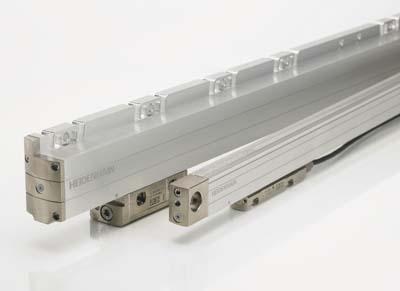
The new absolute LC 115 and LC 415 sealed linear encoders from HEIDENHAIN are now available for use on machines with measuring lengths up to 4240mm. Their double sealing lips on the LC 115 version protect against contamination, and their extrusions ensure high vibration resistance, making these encoders extremely strong on the accuracy front.
These new encoders improve upon HEIDENHAIN's LC xx3 series, as the LC 115/415 now focus on the requirements for purely-serial absolute systems. This product introduction has opened with the safety-related purely-serial Endat 2.2 (up to 16 MHz) encoder version. Soon new interfaces can also be paired with these encoders such as from Fanuc (ai), Siemens (DRIVE-CLiQ) and Mitsubishi (High Speed Interface up to 5 MHz).
The Functional-safety (FS) encoder versions are available for the EnDat 2.2 interface and in the near future DRIVE-CLiQ interface. This means that these encoders can be used as single-encoder systems in safety-related applications, such as in axes with a linear motor. In addition to safe processing of the position values, these encoders provide fault exclusions for the loosening of the mechanical coupling for various types of mounting.
As mentioned, the LC 115 features an optimized sealing design with two successive pairs of sealing lips. When compressed air is introduced into the scale housing, a very effective seal between the two sealing lip pairs is the result. This protects the DIADUR graduation inside, which is responsible for the positioning accuracy, from contamination by dust, chips and coolant.
The resolution of the LC 115 and the LC 415 with an accuracy grade of 3µm was increased from 5 nm to 1 nm, compared to past LC xx3 series.
Contact Details
Related Glossary Terms
- coolant
coolant
Fluid that reduces temperature buildup at the tool/workpiece interface during machining. Normally takes the form of a liquid such as soluble or chemical mixtures (semisynthetic, synthetic) but can be pressurized air or other gas. Because of water’s ability to absorb great quantities of heat, it is widely used as a coolant and vehicle for various cutting compounds, with the water-to-compound ratio varying with the machining task. See cutting fluid; semisynthetic cutting fluid; soluble-oil cutting fluid; synthetic cutting fluid.
- linear motor
linear motor
Functionally the same as a rotary motor in a machine tool, a linear motor can be thought of as a standard permanent-magnet, rotary-style motor slit axially to the center and then peeled back and laid flat. The major advantage of using a linear motor to drive the axis motion is that it eliminates the inefficiency and mechanical variance caused by the ballscrew assembly system used in most CNC machines.

